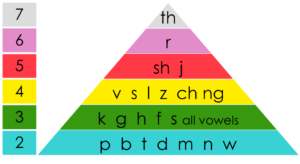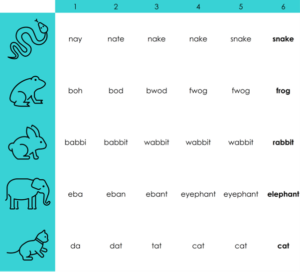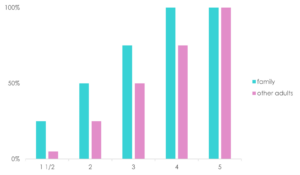Speech sounds
What are speech sounds?
Speech sounds are the sounds we use for talking. We use our tongue, lips, teeth, and other parts of our mouth to create different speech sounds. Speech sounds are not the same as letters. For example, the word ‘sheep’ has five letters, but only three sounds: ‘sh’ ‘ee’ ‘p’.
When do children learn different speech sounds?
As children learn to talk, they gradually learn to make more and more speech sounds. This means that they cannot say all speech sounds straight away. Some sounds like ‘m’ are easier to make than sounds like ‘th’. The chart below shows the ages that children who speak English can normally say different sounds.

Children who can’t make these speech sounds at these ages might need extra help from a speech and language therapist. Children may lisp ‘s’ sounds until around age four or five. See our factsheet on lisps.
Even when children can make a speech sound by itself, it can be much trickier to use speech sounds when saying whole words and sentences! Children often find simpler ways to say words when they are finding a speech sound tricky. This chart shows examples of how your child might say words at different ages:

By five or six years old, nearly all words will be clear and easy to understand. Children who say words like a much younger child, or who say their words in an unusual or unpredictable way, might need extra help from a speech and language therapist.
I can understand everything my child says, but other people can’t.
Families can often understand their child much better than other people. Families might be able to guess what their child is talking about and they learn to tune into how their child says words. It can be much harder for other people who don’t know your child! Here is a rough guide about how clear your child’s talking should be at different ages:

What causes challenges with speech sounds?
Children’s speech is often unclear when they first start to talk, but most children will get clearer in time. Some children, though, have particular challenges making or using speech sounds and will need extra help from a speech and language therapist to talk clearly. We often do not know why a child has challenges using speech sounds, but it can be linked to:
- Challenges with other areas of their communication skills, for example talking and understanding words
- Glue ear (see glue ear page for more information)
- Cleft palate
- Having other family members who needed help with their speech sounds.
What about dummies?
In the past, professionals usually warned against using a dummy after age one as it could cause problems with speech sounds. Recently, studies show that this may not be completely true. For most children, their speech sound challenges are not caused by dummies. We have more information on the pros and cons of dummies here.
I am worried about my child’s speech sounds, what should I do?
If the information here has made you think that your child’s speech sounds are not as clear as other children their age, it is best to talk to your child’s nursery or school, or contact a speech and language therapist. Please see our ‘How do I find a speech and language therapist’ guide for more information.
We also have a free speech and language advice line, which is a confidential phone call with an experienced speech and language therapist. During the 30-minute call, you will be given the opportunity to talk through your concerns and questions regarding your child’s development. You can book your phone call here.
What can I do to help my child at home?
- Focus on trying to understand what your child is saying, rather than how they are saying it. Turn off any background noise and get down to their level so you can see and hear each other easily.
- It is usually best not to correct your child or ask them to copy you saying tricky sounds or words.
- Model words. This means saying the word correctly to your child, but not making them repeat it after you. You can do this if you hear them make a mistake. Try to repeat the word a few times for your child. For example, if they say, ‘Mummy, there’s a tat!’, you could say, ‘Oh yes a cat! A ginger cat. What a lovely cat.’
- Show your child how to use other ways to communicate what they want and need. Our information on visual supports is a good starting point.
- Listening to and playing with sounds and music can help develop your child’s awareness of sounds. Things to try:
- Sing nursery rhymes or read rhyming books together. See if your child can finish the rhyme: Jack and Jill went up the… (hill).
- Sing, dance or clap along to their favourite music and songs.
- Play with musical instruments. Copy each other’s tune or rhythm.
- Drum together: Beat out a rhythm together using drums or household objects like pans and spoon.
We don’t suggest trying mouth exercises such as practicing blowing or sucking. Mouth exercises are not helpful for most children with speech sound challenges.
Useful websites:
